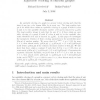69 search results - page 2 / 14 » The two possible values of the chromatic number of a random ... |
COMBINATORICS
2007
13 years 5 months ago
2007
We investigate the notion of quantum chromatic number of a graph, which is the minimal number of colours necessary in a protocol in which two separated provers can convince a refe...
COMBINATORICA
2011
12 years 5 months ago
2011
Given independent random points X1, . . . , Xn ∈ Rd with common probability distribution ν, and a positive distance r = r(n) > 0, we construct a random geometric graph Gn wi...
KDD
2012
ACM
11 years 7 months ago
2012
ACM
We study a novel clustering problem in which the pairwise relations between objects are categorical. This problem can be viewed as clustering the vertices of a graph whose edges a...
IPL
1998
13 years 4 months ago
1998
An equitable coloring of a graph is a proper vertex coloring such that the sizes of any two color classes differ by at most one. The least positive integer k for which there exis...
COMBINATORICA
2008
13 years 5 months ago
2008
A random geometric graph Gn is constructed by taking vertices X1, . . . , Xn Rd at random (i.i.d. according to some probability distribution with a bounded density function) and...


